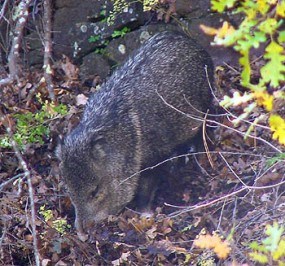
NPS Photo by Barry Nielsen Mammal species in the monument might not always be the easiest to find, but the park is home to a broad diversity of them. The most frequently seen are mule deer, javelina, and squirrels, but with patience, knowledge of their habits, and a keen eye, other species can be found too. Gray foxes, beavers, raccoons, bats, small rodents, coyotes, desert cottontails, bobcats, and even black bears and mountain lions have all been spotted here! Below you can find information about some of our more unusual and frequently sighted neighbors. 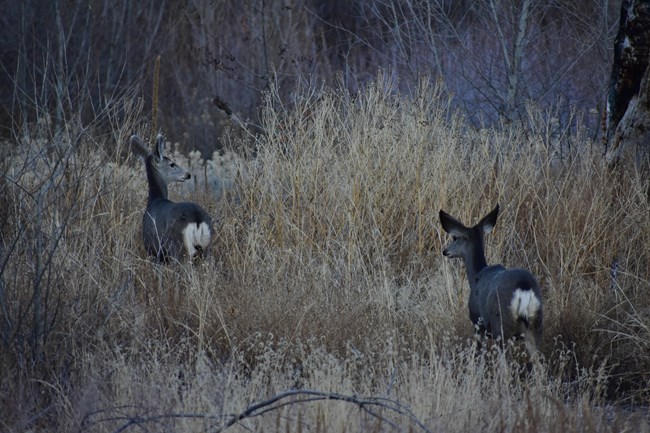
NPS Photo Mule deerAlso known as: muley, black-tailed deer, burro deerSize: Total length about 63 inches (5 feet), adults average weight 150 pounds for does and 225 pounds for bucks. Habitat: They can be found from desert shrub lands to coniferous forests; prefer vegetation or physical features that provide cover. Named for their huge ears and black-tipped tails, they can be easily distinguished from their cousins, the white tail, by their ‘boxy’ body shape and distinctive bouncy gait. The males’ antlers are also forked or branched evenly. Their coloration varies from dark gray in winter to reddish brown in summer. Most active in the early morning and late evening, these deer are intermediate feeder/browsers, preferring leaves and twigs to grass. In wild populations, males seldom live longer than 8 years, and females seldom live longer than 14 years. In 1926, mule deer reached a population low point of around 41,000 in New Mexico. Today, there are approximately 300,000 mule deer in the state. 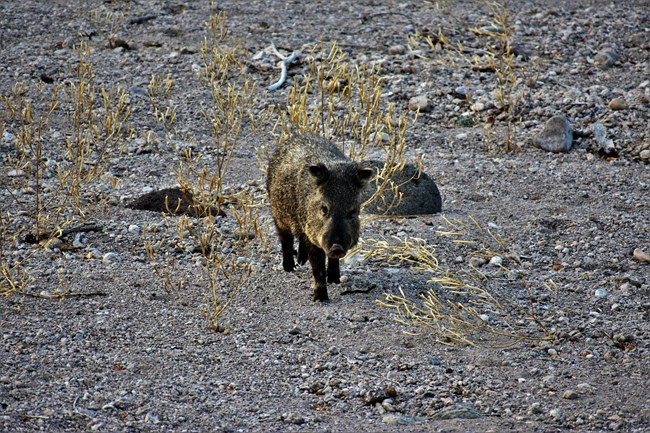
NPS Photo Collared peccaryAlso known as: javelina, musk hog, skunk pigSize: About 36 inches (3 feet) nose to tail; weighs 30 to 60 pounds. Habitat: In the Southwest, desert grasslands and brushy foothills, usually near water. They can also be found in foothills in chaparral, oak and pine woods. The collared peccary resemble pigs, but are from a different family than pigs and wild boars. They are different in size (smaller), appearance, number of teeth and a distinctive musky scent. The scent gland helps these social animals identify who is and who is not in their family, as well as the boundaries of their territory. They rub each other several times a day to transfer their scent, as well as ‘mark’ their territory with the scent gland. Groups can be as large as 30, but usually 20 or so. They can live a relatively long life of up to 20 years, but average lifespan is 13. Collared peccaries are primarily herbivorous and have complex stomachs for digesting coarsely chewed food. Favorite foods include mesquite beans and fruits and pads of prickly pear cactus. They also use their tough, disk-shaped snout to turn over dead vegetation in search of roots and new shoots. Despite all this supplementary diet, the main dietary components of this species are agaves and prickly pears. They have poor eyesight but keen sense of smell. At the first sign of danger, they freeze, emit their musky scent and click their tusks. Generally, they will flee rather than behave aggressively. 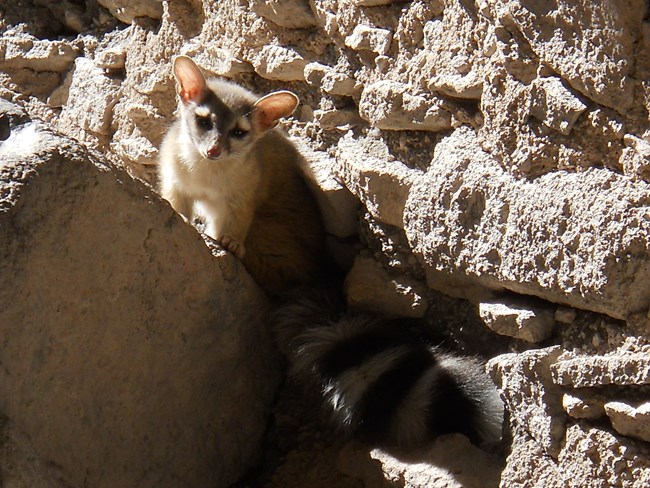
NPS photo RingtailAlso known as: ringtail cat, miner’s cat 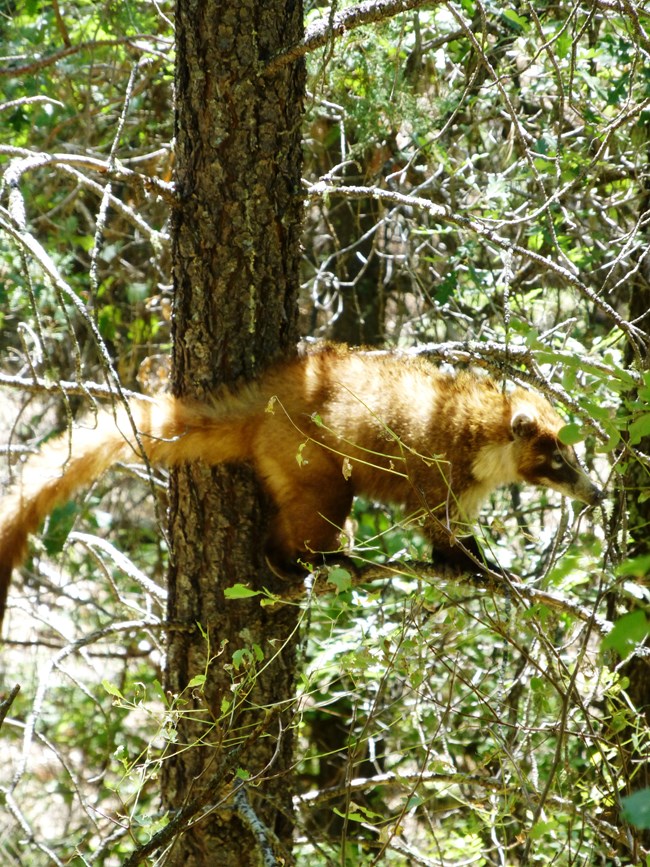
NPS Photo White-nosed coatiAlso known as: coatimundi, hog-nosed coon, gato soloSize: Total length about 41 inches, of which half is its tail. Males are much larger than females. Small females can weigh as little as 5.5 lbs, while large males can weigh as much as 27 lbs. Habitat: Oak woodlands, adjacent grasslands, and mountain ranges These animals are in the raccoon family, but unlike their cousins, they are diurnal (roaming and hunting during the day) and love company. They live and forage in bands of 4 to 50, typically adult females and their young. The males leave the group at age 2 and rejoin only when finding a mate. With their tails up in the air, and their flexible noses to the ground, these animals ‘root’ through the soft forest floor to unearth small mammals and reptiles, insects, worms and tubers (root plants). Using their long curved front claws, they shred logs on the ground, overturn rocks, and dig in soil to find insects and small animals to eat. Talented climbers, they find fruit, berries and bird eggs in trees, using their long tails for balance as they leap from limb to limb. The White-nosed coati is plantigrade with shorter forelegs than hind legs. The feet are black and have naked soles. The forefeet also have bent claws. The tapering tail of extreme length is covered with black rings and held erect while walking. In the wild, these animals have a life expectancy of approximately 14 years. White-nosed coatis are classified as an endangered species in New Mexico. 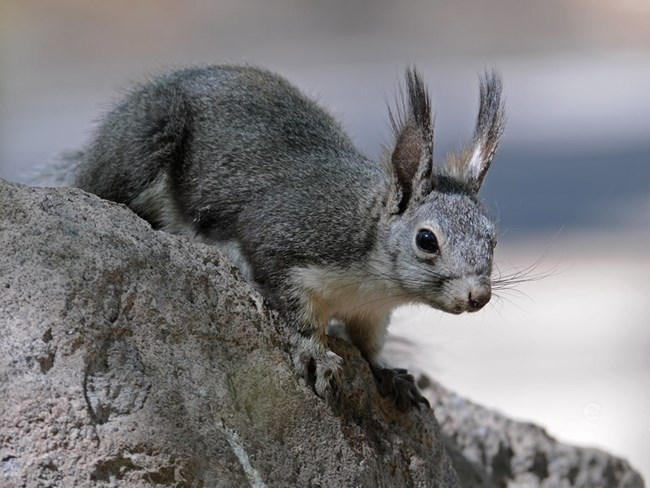
NPS Photo Abert's squirrel(pronounced a-bear)Also known as: Tassel-eared squirrel Size: Total length nose to tip of tail about 24 inches; tail alone about 12 inches Habitat: Mostly Ponderosa pine forests, sometimes mixed coniferous forests. There are 3 different subspecies in New Mexico. Abert’s squirrels depend on the Ponderosa pine for food, shelter, and nesting sites. They eat the Ponderosa seeds, bark, buds and male cones. Clipped needles on the ground can indicate the squirrels feeding above. They also enjoy mushrooms, depending on their moisture content for water, forage for mistletoe, acorns, insects, occasionally carrion (dead animals), shrubs, and grasses. They also nibble on shed antlers and other bones for mineral content. These squirrels do not hibernate but may sleep through periods of cold weather. Unlike other squirrels, they do not ‘cache,’ or store food. Abert’s squirrels show a great deal of social communication during the spring at the start of breeding season. These squirrels are much less social in the summer, fall and winter. They are mostly solitary and maintain distance among individuals. A somewhat contradictory report observed most squirrels sharing nests frequently. They use several communication behaviors: vocal, visual, touch, and smell or taste. These squirrels make a variety of sounds including clucks, barks, screeches and squeals. Their sounds may be identified from other nearby squirrel species due to its high pitch. 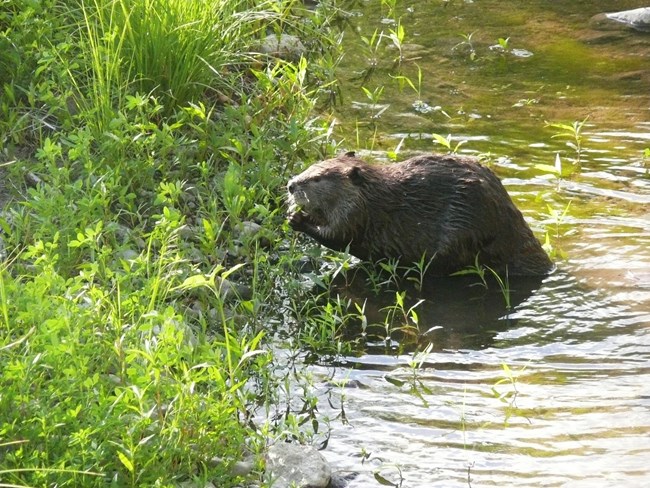
American beaverSize: Body 25 to 35 inches, tail, 9 to 12 inchesHabitat: Streams, rivers, and lakes with trees on the banks About: Outside of human beings, beavers impact landscapes more than any other animal in North America. When they create the dams they are so famous for, they establish wetlands that slow floodwaters, prevent erosion, and raise water tables. This process creates varied and diverse ecosystems that affect all of the wildlife in the area while the creation and subsequent filling of ponds can affect the landscape for thousands of years even after they leave the area. Beavers are the largest rodent in North America. They feed on bark and cambium (the soft underbark of trees) and often completely chew through trees for use in construction of dams and lodges. For this reason, their front teeth never stop growing. Beavers live in lodges. These are often built out of the trees they cut down, woven together with sticks and grass then plastered with mud. Particularly in the Southwest U.S. where riparian trees can be scarce, they will create lodges in the sandy or muddy banks of the river they are residing in. There will often be up to 8 individuals living in a lodge with younger siblings living with the parents for up to two years before leaving to establish their own lodge. Beavers have a very distinct tail that is broad and flat, covered with large black scales. The tail, along with their webbed feet, help in swimming and is used to warn other beavers by slapping it against the water loudly. 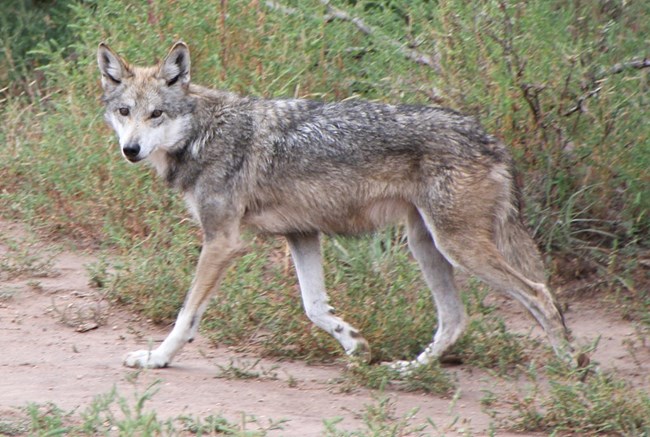
Mexican gray wolfSize: Up to 5 and ½ feet from tip nose to tip of tail, is 28 to 32 inches tall at the shoulder, and weighs 50 to 80 pounds as an adultHabitat: Rangeland, desert and forest About: The Mexican Gray wolf became endangered officially in the US in 1976, due to unregulated trapping, hunting and poisoning. It is the smallest of North America's gray wolves, and is distinguished by its smaller, narrower skull and its darker pelt, which is yellowish-gray and heavily clouded with black over the back and tail. Its ancestors were likely the first gray wolves to enter North America. The Mexican wolf was first described as a distinct subspecies in 1929 by Edward Nelson and Edward Goldman. All wolves, including the Mexican Gray, have complex social lives. The group is usually 5 or 6 in number, led by a dominant breeding pair. All adults in the pack share the pup-raising duties, such as protecting, feeding, and training to stalk and hunt. Pups mature at the age of 2 years and become adult members of the pack at that time. Wolves are carnivores (meat eaters), hunting small and large prey, from mice and rabbits to deer and elk. Other Common Mammals
| ||
Last updated: November 14, 2022
